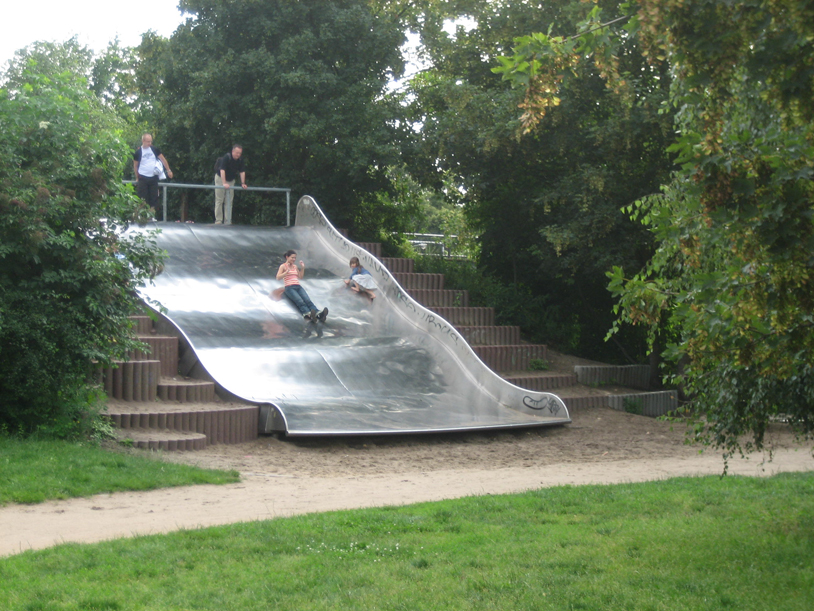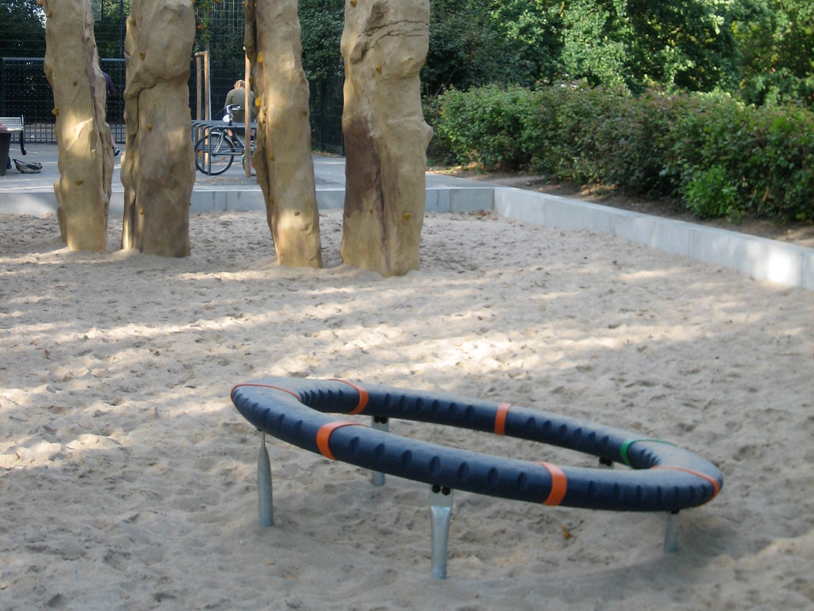
Install recumbent bicycle benches at CAP Metro Bus stops?
Outdoor stair climbers on Congress Ave.?
In-ground trampolines on Guadalupe?
Criss-crossing balance beams on 2nd Street?
Concrete ping pong tables at intersections throughout town?
Climbing boulders on East 5th Street?
Let’s face it, many of you would consider me quite out of my mind if I were to suggest that we turn Austin into one big playground, a landscape of physical challenges and gleeful adventures by installing outdoor stair climbing machines, 30 foot wide slides, rock climbing boulders and in-ground trampolines at our bus stops, on our sidewalks and in the unused spaces of our overly wide streets. The diagnosis of insanity would surely be cemented were I to claim that by creating a streetscape that is more challenging to traverse we will lure children away from the television, increase their mobility, create a generally healthier Austin and decrease our community health care costs.
On the surface it does indeed sound like a pretty absurd idea with little precedent in Texas, much less the United States. The standard assumption is that children generally would rather play video games or watch television than go outside; we’ve simply lost them to the powerful pull of these devices. Furthermore, play occurs on playgrounds, places that are specifically designed for children where they can safely be themselves, protected from the rest of the world by a fence or significant physical boundary.
Adult exercise and feats of daring-do?
Like play, they take place in their own assigned locations such as Walnut Creek, the Greenbelt or in the confines of a gym at designated times during the day. How about adults jumping on a trampoline or going down a slide? Certainly not, that’s kids stuff and no right-minded adult would ever be caught dead doing such things.And yet at the same time we fail to recognize that many of these assumptions may be indirectly to blame for startling decreases in independent childhood mobility as evidenced by the Sheffield Study that I recounted in the previous Weekly What If? and significant increases in related health problems for all ages.
Sure, our increased dependence on cars has played a big role in creating our current conundrum but many of the aforementioned assumptions about play, exercise, etc. that are born out of a relentless push for maximum efficiency and safety are equally at fault. We have removed so much risk from our playgrounds and cities, likewise centralizing our activities to such a degree that we have created landscapes of isolation and boredom that bare little resemblance to the wonderful childhood stories that many of you have shared over the past two weeks. With places such as Broward County, Florida banning running on their playgrounds or children’s independent explorations limited to the end of the cul de sac, it’s little wonder that we have ‘lost’ them to much more relatively stimulating endeavors such as watching television or playing video games. Likewise, just as we have made it difficult and unappealing for children to play outdoors, we have made exercise and adventure time consuming, and expensive add-ons to our already overbooked everyday lives.
Play, Exercise and Adventure: Everywhere.
Instead of bottling up exercise equipment in the gym, isolating feats of daring-do to the Greenbelt and cordoning children’s play to singular playgrounds, disperse the individual pieces of these things in the extra space of our streets, sidewalks and public infrastructure. In short, create an urban landscape that actually mimics how we played as children, making it easy and appealing for us to play or exercise. Much of the framework or physical space for doing this already exists.Copy the Malaysians by placing random exercise equipment along sidewalks and at CAP Metro bus stops. Mimic the city of Roubaix in France and narrow many of our overly wide streets to create small areas of easily accessible play or adventure. Make our Park(ing) Day explorations permanent, transforming our errant or excess parking spaces into Maya Lin-esque landscapes or small gardens. Follow China or Berlin’s lead and make walking down our wider sidewalks challenging or whimsical by varying sections of sidewalk surface treatment to improve our joint strength and balance; inserting small boulders for climbing; or locating small in-ground trampolines (pictured) in the sidewalk that make it nearly impossible to resist the occasional ‘bounce’.
It is important to mix these insertions of play, challenge and exercise in places into the patterns of our everyday lives but it’s also essential that they be used to help bridge the physical distances between existing facilities such as schools, libraries, playgrounds and Austin’s remarkable collection of woefully disconnected green spaces. Tying these parks together with bike lanes, sidewalks, paths and even signage or a branding system pointing to other nearby parks, playgrounds, schools or community facilities will go a long way towards increasing everyone’s mobility and well-being. However, studies have shown that for both children and adults, the relative proximity of play spaces, parks, schools gyms, etc. to the home is equally if not more important than infrastructure in determining whether people will use a facility and how they will get there.Foster a culture of use by linking the individual insertions as a part of a city wide play and adventure circuit, mimicking vitaparcours, the health insurance company sponsored exercise trails in Switzerland. Adapt and take advantage of new technologies such as the Freikometer, a device that records and then indirectly rewards children who ride their bikes to school in Boulder, Colorado (doubling bicycle ridership) to further change attitudes about play, exercise and mobility. Similarly, create a downloadable app for smart phones that geo-locates a user at a particular adventure and automatically records the amount of time spent at that activity so people can see that even ten minutes spent on a stair climber during a coffee break plus five minutes on a recumbent bicycle bench has benefits to one’s health.
Still skeptical?
Elderly people using playground equipment? Adults jumping on trampoline see-saws and sliding down slides? Children breaking into fenced-off areas to use outdoor elliptical machines continuously for 20 minutes? Adults competing to see who can stay on the merry-go-round balance beam the longest?Honestly, despite knowing about many of these things well in advance of my visit to Berlin this summer, I too was skeptical. However, throughout my stay and research there I saw the above-mentioned scenes repeated time and time again. So, as exciting as the Freikometer may be as a potential tool for changing the culture of mobility, play and exercise, if we create a physical landscape in which such activities are fun, challenging and readily accessible, we simply may not need technology to save the day. Instead, a
more pressing problem may be how to keep people from continuing to use these devices when they need to be repaired or refurbished but I think that’s a worthy trade off for a more mobile and healthy populace.
————-
Thanks to everyone who shared your great childhood stories of roaming and adventure. By the way, if anyone comes across photographs of Roubaix’s sidewalk playgrounds, please let me know. Despite finding numerous references to these playgrounds, I’ve only be able to find one nearly illegible picture of them. Thanks.
————-
Want to read more about some of the people, places and ideas discussed in this article?
Elderly playgrounds and outdoor exercise equipment-
A recent Reuters article on elderly playgrounds in Japan (here)
Another article on Japan’s elderly playgrounds (here)
A great article on Finnish research on playgrounds for multiple generations (here)
A good article on Beijing’s outdoor exercise equipment (here)
A Malaysian company that makes outdoor exercise equipment (here)
Technology encouraging new attitudes towards mobility and exercise-
The Freikometer (here)
Exercise trails-
Vitaparcours (here)
The merits of creating challenging landscapes-
Gins and Arakawa’s Life Extending Villa (here)
The benefits of walking on cobblestones (here)
——-
The Weekly What If? is a weekly column by Alex Gilliam. Alex Gilliam is the founder of Public Workshop, an organization dedicated to helping individuals, schools, and communities achieve great things through design. The Weekly What If? focuses on re-imagining various aspects of how Austin, as a city, functions and feels. The goal is to foster a larger conversation about the present and future shape of our City.
Do you have a suggestion for something that needs to be re-imagined in Austin? Please email your suggestions to Alex:
alex (at) publicworkshop.us




Posted on February 21st, 2010 at 1:41 pm by publicworkshop in Writing